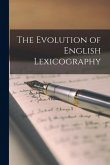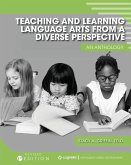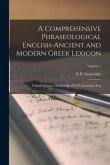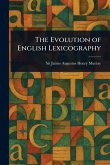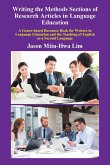Justyna Lesniewska
Articles in English as a Second Language - A Phraseological Perspective
A Phraseological Perspective
Justyna Lesniewska
Articles in English as a Second Language - A Phraseological Perspective
A Phraseological Perspective
- Broschiertes Buch
- Merkliste
- Auf die Merkliste
- Bewerten Bewerten
- Teilen
- Produkt teilen
- Produkterinnerung
- Produkterinnerung
The aim of this study is to provide an overview of research findings on the acquisition and use of articles in English as a second language, investigated from a phraseological perspective. It also presents an examination of various linguistic accounts of the English article system with respect to their application to English language teaching.
Andere Kunden interessierten sich auch für
![The Evolution of English Lexicography The Evolution of English Lexicography]() AnonymousThe Evolution of English Lexicography17,99 €
AnonymousThe Evolution of English Lexicography17,99 €![Teaching and Learning Language Arts from a Diverse Perspective Teaching and Learning Language Arts from a Diverse Perspective]() Teaching and Learning Language Arts from a Diverse Perspective88,99 €
Teaching and Learning Language Arts from a Diverse Perspective88,99 €![The Oxford History of English Lexicography The Oxford History of English Lexicography]() The Oxford History of English Lexicography464,99 €
The Oxford History of English Lexicography464,99 €![A Comprehensive Phraseological English-Ancient and Modern Greek Lexicon: Founded Upon a Manuscript of G.P. Lascarides, Esq; Volume 2 A Comprehensive Phraseological English-Ancient and Modern Greek Lexicon: Founded Upon a Manuscript of G.P. Lascarides, Esq; Volume 2]() G. P. LascaridesA Comprehensive Phraseological English-Ancient and Modern Greek Lexicon: Founded Upon a Manuscript of G.P. Lascarides, Esq; Volume 232,99 €
G. P. LascaridesA Comprehensive Phraseological English-Ancient and Modern Greek Lexicon: Founded Upon a Manuscript of G.P. Lascarides, Esq; Volume 232,99 €![The Evolution of English Lexicography The Evolution of English Lexicography]() James Augustus Henry MurrayThe Evolution of English Lexicography14,99 €
James Augustus Henry MurrayThe Evolution of English Lexicography14,99 €![Writing the Methods Sections of Research Articles in Language Education Writing the Methods Sections of Research Articles in Language Education]() Jason Miin-Hwa LimWriting the Methods Sections of Research Articles in Language Education20,99 €
Jason Miin-Hwa LimWriting the Methods Sections of Research Articles in Language Education20,99 €![A Phraseological English-Latin Dictionary A Phraseological English-Latin Dictionary]() Charles Duke YongeA Phraseological English-Latin Dictionary27,99 €
Charles Duke YongeA Phraseological English-Latin Dictionary27,99 €-
-
-
The aim of this study is to provide an overview of research findings on the acquisition and use of articles in English as a second language, investigated from a phraseological perspective. It also presents an examination of various linguistic accounts of the English article system with respect to their application to English language teaching.
Hinweis: Dieser Artikel kann nur an eine deutsche Lieferadresse ausgeliefert werden.
Hinweis: Dieser Artikel kann nur an eine deutsche Lieferadresse ausgeliefert werden.
Produktdetails
- Produktdetails
- Verlag: Uniwersytet Jagiellonski, Wydawnictwo
- Seitenzahl: 230
- Erscheinungstermin: 12. Oktober 2021
- Englisch
- Abmessung: 146mm x 204mm x 15mm
- Gewicht: 294g
- ISBN-13: 9788323346913
- ISBN-10: 8323346917
- Artikelnr.: 59984043
- Herstellerkennzeichnung Die Herstellerinformationen sind derzeit nicht verfügbar.
- Verlag: Uniwersytet Jagiellonski, Wydawnictwo
- Seitenzahl: 230
- Erscheinungstermin: 12. Oktober 2021
- Englisch
- Abmessung: 146mm x 204mm x 15mm
- Gewicht: 294g
- ISBN-13: 9788323346913
- ISBN-10: 8323346917
- Artikelnr.: 59984043
- Herstellerkennzeichnung Die Herstellerinformationen sind derzeit nicht verfügbar.
Justyna Le¿niewska
Introduction
Chapter 1
Articles: Descriptive approaches
1.1. Introduction
1.2. The classification of articles as parts of speech and sentences
1.3. The indefinite article
1.4. The definite article
1.5. The zero article / bare noun phrase
1.6. Conclusions
Chapter 2
Key concepts in the study of articles
2.1. Introduction
2.2. Reference
2.3. Information flow
2.4. Countability
2.4.1. The count / non-count distinction
2.4.2. Implications for L2 acquisition
2.4.3. Some uses of articles are very difficult to explain
2.5. Definiteness
2.6. Conclusions
Chapter 3
Other approaches to articles
3.1. Introduction
3.2. Socio-pragmatic approaches
3.3. Cognitive accounts of definite article use
3.4. The generative tradition
3.5. Corpus-based perspectives
3.6. Conclusions
Chapter 4
Articles as a source of difficulty in SLA
4.1. Introduction
4.2. Theoretical approaches to difficulty
4.2.1. Difficulty as cognitive complexity
4.2.2. Feature-related difficulty
4.2.3. Context-related difficulty
4.2.4. Learner-related difficulty
4.2.5. Some final words on objectivity
4.2.6. Articles and feature-related difficulty
4.2.7. Salience
4.2.8. Context- and learner-related difficulty
4.2.9. Language patterns versus metalinguistic propositions and rule
difficulty
4.3. Implicit versus explicit learning and knowledge
4.4. Conclusions
4.4.1. High difficulty level
4.4.2. Implicit learning
4.4.3. Limited usefulness of metalinguistic propositions
Chapter 5
Articles in SLA research
5.1. Introduction
5.2. Crosslinguistic aspects
5.3. Semantic universals and the acquisition of articles
5.4. The sequence of acquisition of articles in L1 and L2 English
5.5. Studies on countability
5.6. Abstractness
5.7. Articles and learners¿ interim rules
5.8. Type of task
5.9. Lexical chunks
5.10. Conclusions
Chapter 6
Articles and ESL teaching
6.1. Introduction
6.2. Articles and the efficacy of corrective feedback
6.3. Other treatments and recommendations concerning the teaching of
articles
6.4. The treatment of articles in teaching materials and pedagogical
grammars
6.5. Conclusions
Chapter 7
Formulaicity
7.1 Introduction
7.2 Speaker-external formulaicity
7.3 Speaker-internal formulaicity
7.3.1 The idiom principle
7.3.2 Theoretical support for the formulaic nature of language processing
7.3.3 Empirical evidence supporting the formulaic nature of language
processing in native speakers
7.4 Formulaicity, frequency and recent trends in linguistics
7.5 Formulaic language in L2 speakers
7.5.1 Speaker-external aspects
7.5.2 Speaker-internal aspects
7.6 Formulaicity and second language teaching: A brief history
7.7 Articles and formulaicity
7.8 Conclusions
Chapter 8
Investigating article use by advanced Polish learners of EFL: The role of
formulaicity
8.1 Introduction
8.1.1 Purpose and rationale
8.1.2 Approach
8.2 Study 1
8.2.1 Participants
8.2.2 Instrument and procedure
8.2.3 Analysis, results and discussion
8.3 Study 2
8.3.1 Participants
8.3.2 Instrument and procedure
8.3.3 Results and discussion
Conclusion
References
Appendix 1
Appendix 2
Appendix 3
Chapter 1
Articles: Descriptive approaches
1.1. Introduction
1.2. The classification of articles as parts of speech and sentences
1.3. The indefinite article
1.4. The definite article
1.5. The zero article / bare noun phrase
1.6. Conclusions
Chapter 2
Key concepts in the study of articles
2.1. Introduction
2.2. Reference
2.3. Information flow
2.4. Countability
2.4.1. The count / non-count distinction
2.4.2. Implications for L2 acquisition
2.4.3. Some uses of articles are very difficult to explain
2.5. Definiteness
2.6. Conclusions
Chapter 3
Other approaches to articles
3.1. Introduction
3.2. Socio-pragmatic approaches
3.3. Cognitive accounts of definite article use
3.4. The generative tradition
3.5. Corpus-based perspectives
3.6. Conclusions
Chapter 4
Articles as a source of difficulty in SLA
4.1. Introduction
4.2. Theoretical approaches to difficulty
4.2.1. Difficulty as cognitive complexity
4.2.2. Feature-related difficulty
4.2.3. Context-related difficulty
4.2.4. Learner-related difficulty
4.2.5. Some final words on objectivity
4.2.6. Articles and feature-related difficulty
4.2.7. Salience
4.2.8. Context- and learner-related difficulty
4.2.9. Language patterns versus metalinguistic propositions and rule
difficulty
4.3. Implicit versus explicit learning and knowledge
4.4. Conclusions
4.4.1. High difficulty level
4.4.2. Implicit learning
4.4.3. Limited usefulness of metalinguistic propositions
Chapter 5
Articles in SLA research
5.1. Introduction
5.2. Crosslinguistic aspects
5.3. Semantic universals and the acquisition of articles
5.4. The sequence of acquisition of articles in L1 and L2 English
5.5. Studies on countability
5.6. Abstractness
5.7. Articles and learners¿ interim rules
5.8. Type of task
5.9. Lexical chunks
5.10. Conclusions
Chapter 6
Articles and ESL teaching
6.1. Introduction
6.2. Articles and the efficacy of corrective feedback
6.3. Other treatments and recommendations concerning the teaching of
articles
6.4. The treatment of articles in teaching materials and pedagogical
grammars
6.5. Conclusions
Chapter 7
Formulaicity
7.1 Introduction
7.2 Speaker-external formulaicity
7.3 Speaker-internal formulaicity
7.3.1 The idiom principle
7.3.2 Theoretical support for the formulaic nature of language processing
7.3.3 Empirical evidence supporting the formulaic nature of language
processing in native speakers
7.4 Formulaicity, frequency and recent trends in linguistics
7.5 Formulaic language in L2 speakers
7.5.1 Speaker-external aspects
7.5.2 Speaker-internal aspects
7.6 Formulaicity and second language teaching: A brief history
7.7 Articles and formulaicity
7.8 Conclusions
Chapter 8
Investigating article use by advanced Polish learners of EFL: The role of
formulaicity
8.1 Introduction
8.1.1 Purpose and rationale
8.1.2 Approach
8.2 Study 1
8.2.1 Participants
8.2.2 Instrument and procedure
8.2.3 Analysis, results and discussion
8.3 Study 2
8.3.1 Participants
8.3.2 Instrument and procedure
8.3.3 Results and discussion
Conclusion
References
Appendix 1
Appendix 2
Appendix 3
Introduction
Chapter 1
Articles: Descriptive approaches
1.1. Introduction
1.2. The classification of articles as parts of speech and sentences
1.3. The indefinite article
1.4. The definite article
1.5. The zero article / bare noun phrase
1.6. Conclusions
Chapter 2
Key concepts in the study of articles
2.1. Introduction
2.2. Reference
2.3. Information flow
2.4. Countability
2.4.1. The count / non-count distinction
2.4.2. Implications for L2 acquisition
2.4.3. Some uses of articles are very difficult to explain
2.5. Definiteness
2.6. Conclusions
Chapter 3
Other approaches to articles
3.1. Introduction
3.2. Socio-pragmatic approaches
3.3. Cognitive accounts of definite article use
3.4. The generative tradition
3.5. Corpus-based perspectives
3.6. Conclusions
Chapter 4
Articles as a source of difficulty in SLA
4.1. Introduction
4.2. Theoretical approaches to difficulty
4.2.1. Difficulty as cognitive complexity
4.2.2. Feature-related difficulty
4.2.3. Context-related difficulty
4.2.4. Learner-related difficulty
4.2.5. Some final words on objectivity
4.2.6. Articles and feature-related difficulty
4.2.7. Salience
4.2.8. Context- and learner-related difficulty
4.2.9. Language patterns versus metalinguistic propositions and rule
difficulty
4.3. Implicit versus explicit learning and knowledge
4.4. Conclusions
4.4.1. High difficulty level
4.4.2. Implicit learning
4.4.3. Limited usefulness of metalinguistic propositions
Chapter 5
Articles in SLA research
5.1. Introduction
5.2. Crosslinguistic aspects
5.3. Semantic universals and the acquisition of articles
5.4. The sequence of acquisition of articles in L1 and L2 English
5.5. Studies on countability
5.6. Abstractness
5.7. Articles and learners¿ interim rules
5.8. Type of task
5.9. Lexical chunks
5.10. Conclusions
Chapter 6
Articles and ESL teaching
6.1. Introduction
6.2. Articles and the efficacy of corrective feedback
6.3. Other treatments and recommendations concerning the teaching of
articles
6.4. The treatment of articles in teaching materials and pedagogical
grammars
6.5. Conclusions
Chapter 7
Formulaicity
7.1 Introduction
7.2 Speaker-external formulaicity
7.3 Speaker-internal formulaicity
7.3.1 The idiom principle
7.3.2 Theoretical support for the formulaic nature of language processing
7.3.3 Empirical evidence supporting the formulaic nature of language
processing in native speakers
7.4 Formulaicity, frequency and recent trends in linguistics
7.5 Formulaic language in L2 speakers
7.5.1 Speaker-external aspects
7.5.2 Speaker-internal aspects
7.6 Formulaicity and second language teaching: A brief history
7.7 Articles and formulaicity
7.8 Conclusions
Chapter 8
Investigating article use by advanced Polish learners of EFL: The role of
formulaicity
8.1 Introduction
8.1.1 Purpose and rationale
8.1.2 Approach
8.2 Study 1
8.2.1 Participants
8.2.2 Instrument and procedure
8.2.3 Analysis, results and discussion
8.3 Study 2
8.3.1 Participants
8.3.2 Instrument and procedure
8.3.3 Results and discussion
Conclusion
References
Appendix 1
Appendix 2
Appendix 3
Chapter 1
Articles: Descriptive approaches
1.1. Introduction
1.2. The classification of articles as parts of speech and sentences
1.3. The indefinite article
1.4. The definite article
1.5. The zero article / bare noun phrase
1.6. Conclusions
Chapter 2
Key concepts in the study of articles
2.1. Introduction
2.2. Reference
2.3. Information flow
2.4. Countability
2.4.1. The count / non-count distinction
2.4.2. Implications for L2 acquisition
2.4.3. Some uses of articles are very difficult to explain
2.5. Definiteness
2.6. Conclusions
Chapter 3
Other approaches to articles
3.1. Introduction
3.2. Socio-pragmatic approaches
3.3. Cognitive accounts of definite article use
3.4. The generative tradition
3.5. Corpus-based perspectives
3.6. Conclusions
Chapter 4
Articles as a source of difficulty in SLA
4.1. Introduction
4.2. Theoretical approaches to difficulty
4.2.1. Difficulty as cognitive complexity
4.2.2. Feature-related difficulty
4.2.3. Context-related difficulty
4.2.4. Learner-related difficulty
4.2.5. Some final words on objectivity
4.2.6. Articles and feature-related difficulty
4.2.7. Salience
4.2.8. Context- and learner-related difficulty
4.2.9. Language patterns versus metalinguistic propositions and rule
difficulty
4.3. Implicit versus explicit learning and knowledge
4.4. Conclusions
4.4.1. High difficulty level
4.4.2. Implicit learning
4.4.3. Limited usefulness of metalinguistic propositions
Chapter 5
Articles in SLA research
5.1. Introduction
5.2. Crosslinguistic aspects
5.3. Semantic universals and the acquisition of articles
5.4. The sequence of acquisition of articles in L1 and L2 English
5.5. Studies on countability
5.6. Abstractness
5.7. Articles and learners¿ interim rules
5.8. Type of task
5.9. Lexical chunks
5.10. Conclusions
Chapter 6
Articles and ESL teaching
6.1. Introduction
6.2. Articles and the efficacy of corrective feedback
6.3. Other treatments and recommendations concerning the teaching of
articles
6.4. The treatment of articles in teaching materials and pedagogical
grammars
6.5. Conclusions
Chapter 7
Formulaicity
7.1 Introduction
7.2 Speaker-external formulaicity
7.3 Speaker-internal formulaicity
7.3.1 The idiom principle
7.3.2 Theoretical support for the formulaic nature of language processing
7.3.3 Empirical evidence supporting the formulaic nature of language
processing in native speakers
7.4 Formulaicity, frequency and recent trends in linguistics
7.5 Formulaic language in L2 speakers
7.5.1 Speaker-external aspects
7.5.2 Speaker-internal aspects
7.6 Formulaicity and second language teaching: A brief history
7.7 Articles and formulaicity
7.8 Conclusions
Chapter 8
Investigating article use by advanced Polish learners of EFL: The role of
formulaicity
8.1 Introduction
8.1.1 Purpose and rationale
8.1.2 Approach
8.2 Study 1
8.2.1 Participants
8.2.2 Instrument and procedure
8.2.3 Analysis, results and discussion
8.3 Study 2
8.3.1 Participants
8.3.2 Instrument and procedure
8.3.3 Results and discussion
Conclusion
References
Appendix 1
Appendix 2
Appendix 3


